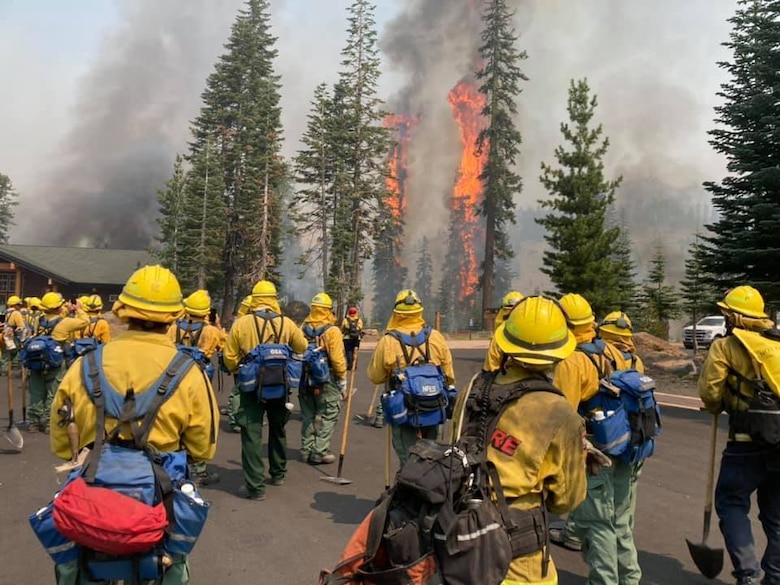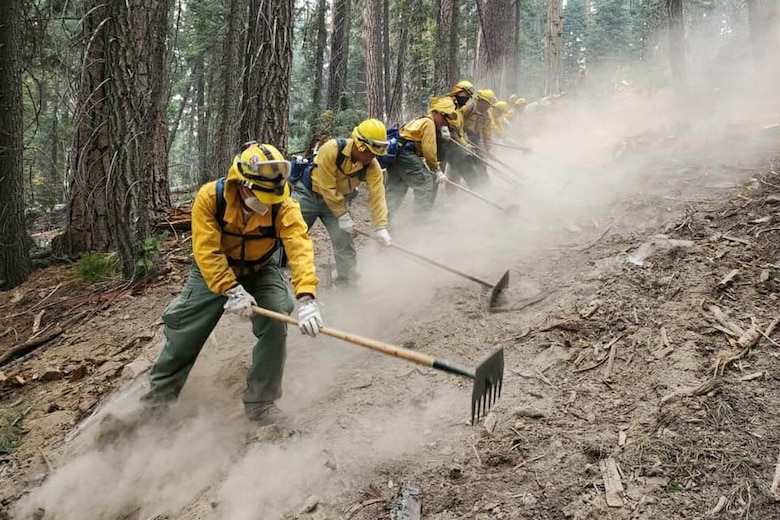Soldiers, Airmen, Sailors and civilians from California and six other states are actively fighting wildfires burning throughout the state.
Nearly 1,000 Cal Guard service members are currently activated for fire missions in the air and on the ground, Army Maj. Gen. David Baldwin, Cal Guard's adjutant general, said Aug. 18 during a press conference held by the California Governor's Office of Emergency Services.
An additional 120 National Guard and Air Force Reserve service members from Nevada, Wyoming, Colorado, Wisconsin, West Virginia and Louisiana augment the fight through the resource-sharing Emergency Management Assistance Compact.
"We're seeing very gusty winds and are seeing it combined with dry conditions and record drought, making this a very, very dangerous and severe situation," said Mark Ghilarducci, director of the California Governor's Office of Emergency Services.
More than 500 service members are serving on Cal Guard hand crews to cut containment lines and reduce fuels on the ground. Baldwin said the crews, which are Type I and Type II rated, are mostly working the Dixie Fire.
At more than 630,000 acres, the Dixie Fire is the largest fire currently burning in California and the second-largest in the state's recorded history. The fire started July 14 and has ripped through parts of Butte, Plumas, Lassen and Tehama counties, leveling more than 1,200 structures in its wake and charting a different course than any previous fire.
"The Dixie Fire is the first fire that we're aware of that has burned from the west side of the mountain range over into the valley floor on the east side of the mountain range," said Chief Thom Porter, director of the California Department of Forestry and Fire Protection (CAL FIRE).
"We don't have any record of that happening before," Porter said.
Soldiers from the California Army National Guard's 870th Military Police Company are staffing traffic control points supporting the California Highway Patrol and the Plumas County Sheriff's Department. They are working in the fire-ravaged towns of Taylorsville and Greenville, easing the burden on local law enforcement and protecting the communities from burglary and looting.
"We are from California. We are members of the community, and we are here to help," said 1st Lt. Matthew Chow, one of the company's platoon leaders.
"On the one hand, most of us are pretty proud of our role here and of being Guardsmen in California," Chow said. "It's nice talking to people … because they're thankful for the assistance from us. On the other hand, I can't say I'm happy to be here because it's kind of sad."
Cal Guard is flying aerial missions in support of the statewide fire effort, Baldwin said. This includes firefighting helicopters, air tankers, and medevac helicopters, in addition to remotely piloted and manned aircraft flying fire mapping and damage assessment flights.
All eight of the U.S. military's Modular Airborne Fire Fighting System-equipped C-130 Hercules are currently in California and operating from Sacramento. Two are assigned to the California Air National Guard's 146th Airlift Wing in Ventura County. The remaining six are based in other states but are in California to drop fire retardant and build containment lines 3,000 gallons at a time.
Cal Guard is leveraging its airborne and space capabilities for fire detection, fire mapping and damage assessment missions.
"We're also using our space-based systems to do initial fire detection to help CAL FIRE and the U.S. Forest Service pounce on fires when they break out, and we can also use those systems for fire mapping and damage assessment," Baldwin said.
Three large fuel tankers and support staff are also activated and positioned east of Redding to refuel firefighting helicopters working the Dixie Fire.

Trees burn within eyesight of a California National Guard hand crew with Joint Task Force 578 during the Dixie Fire, Aug. 16, 2021, in Northern California. The task force is part of the mutual aid system in support of California Department of Forestry and Fire Protection. (U.S. Army National Guard photo by 1st Sgt. Harley Ramirez)

A hand crew from the California National Guard's Joint Task Force 578 fights the Dixie Fire as part of the mutual aid system in support of California Department of Forestry and Fire Protection, Aug. 16, 2021, in Northern California. (U.S. Army National Guard photo by 1st Sgt. Harley Ramirez)






